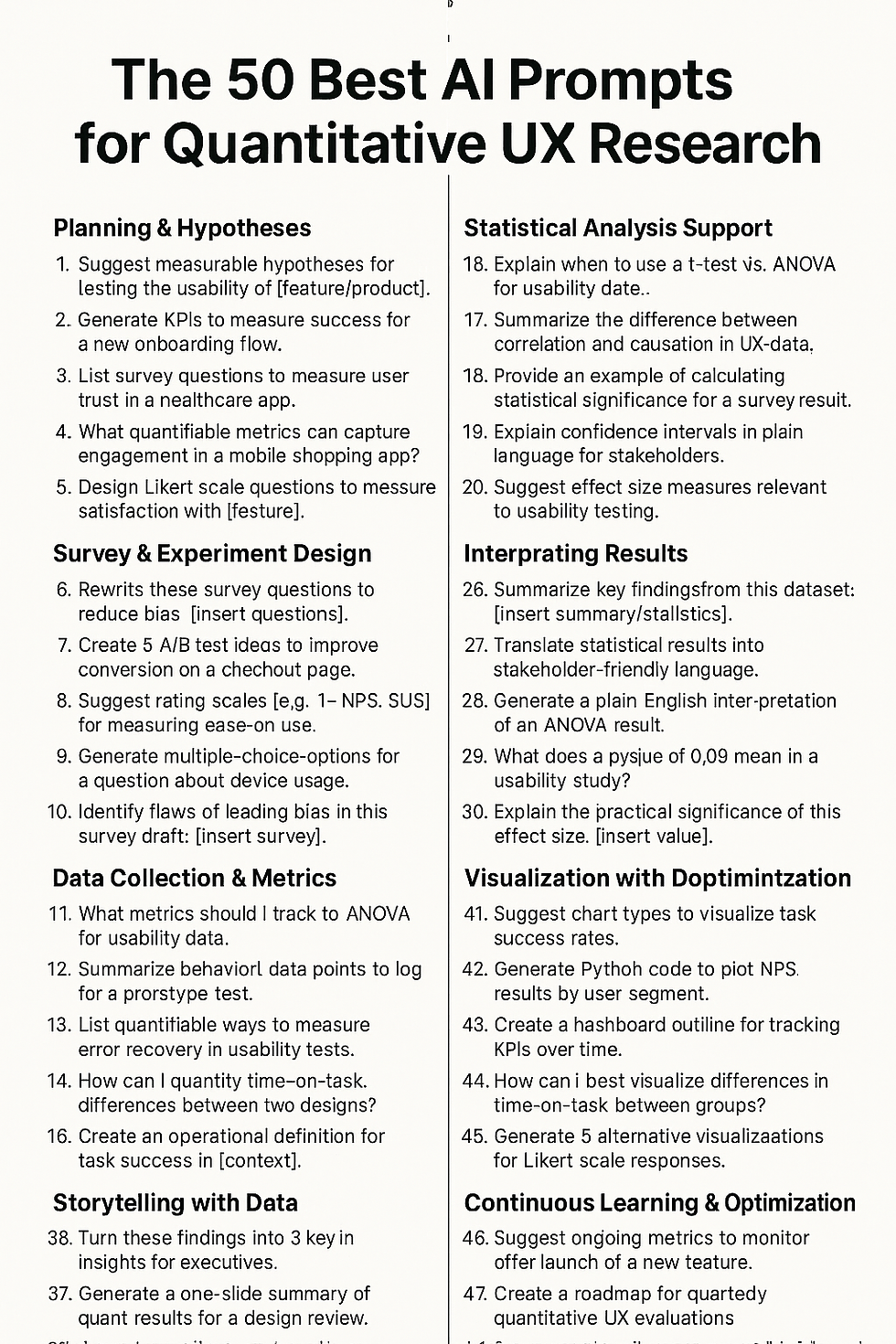The Best 50 AI Prompts for Qualitative UX Research
- Philip Burgess
- Aug 22
- 3 min read
By Philip Burgess - UX Research Leader
Artificial Intelligence is becoming a powerful partner for UX researchers, not a replacement. With the right prompts, AI can accelerate analysis, uncover themes, draft reports, and even suggest new research questions. Below are 50 of the best AI prompts for qualitative UX research, organized by stage of the research process.
1. Research Planning
“Suggest 5 open-ended interview questions to understand user frustrations with [product/feature].”
“Generate a discussion guide for a 45-minute user interview on [topic].”
“Rewrite these interview questions to be neutral and non-leading.”
“What follow-up probes could I use if a participant gives short answers?”
“Suggest 10 diary study prompts that uncover emotional reactions over time.”
2. Participant Recruitment
“Draft a screener survey to identify users who meet [criteria].”
“Rewrite this screener to avoid bias and leading questions.”
“Suggest additional screening questions to uncover hidden motivations.”
“How can I phrase recruitment ads to resonate with [target audience]?”
“Create inclusive demographic questions for a UX study.”
3. Data Collection
“Generate probes to encourage deeper storytelling in interviews.”
“Suggest non-verbal cues I can use to build rapport in remote interviews.”
“Give me alternative ways to ask about sensitive topics in research.”
“How do I adapt my interview script for participants with low tech literacy?”
“Draft 10 warm-up questions to build comfort in a focus group.”
4. Data Analysis
“Summarize these interview transcripts into key themes.”
“Highlight emotional words and patterns in this transcript.”
“Cluster participant quotes into 3–5 categories.”
“Generate affinity diagram categories from this dataset.”
“Suggest emerging insights from these 5 user stories.”
5. Synthesizing Insights
“Turn these raw notes into ‘user need’ statements.”
“Reframe these insights as opportunity areas.”
“Suggest ‘How might we…’ questions based on these findings.”
“Write 3 personas from this dataset with goals, frustrations, and behaviors.”
“Draft journey map stages from these qualitative insights.”
6. Storytelling & Reporting
“Turn this research finding into a compelling story for stakeholders.”
“Rewrite these insights for executive-level brevity.”
“Translate participant quotes into plain-language summaries.”
“Create 5 slide headlines to highlight research impact.”
“Generate metaphors or analogies to explain this user pain point.”
7. Cross-Checking & Validation
“Suggest alternative explanations for this observed behavior.”
“What biases could be influencing this research finding?”
“Give me 3 counterpoints to this insight.”
“How could I triangulate this qualitative finding with quantitative methods?”
“Rewrite these findings to highlight confidence levels.”
8. Collaboration & Workshops
“Generate 10 brainstorming prompts for a design workshop.”
“Suggest activities to turn research insights into design ideas.”
“Write an icebreaker that connects to our research topic.”
“Facilitate a team activity to prioritize pain points.”
“Draft a workshop script to co-create solutions with stakeholders.”
9. Ethical & Inclusive Research
“Rewrite this consent form in plain, accessible language.”
“Suggest ways to make remote interviews more inclusive for participants with disabilities.”
“Generate inclusive language alternatives for sensitive demographic questions.”
“How can I reduce participant burden in a 60-minute study?”
“Highlight potential ethical issues in this research plan.”
10. Future-Focused Prompts
“Predict how these user needs might change in 5 years.”
“Suggest future research questions based on these findings.”
“How can AI help me speed up qualitative coding without losing nuance?”
“What are risks of over-relying on AI in qualitative research?”
“Suggest ways AI and human researchers can complement each other in analysis.”
Final Thoughts
These 50 AI prompts are not meant to replace the art of qualitative research—they’re designed to amplify your capabilities as a researcher. By using them strategically, you can move faster, deepen insights, and communicate findings more effectively while still bringing your human empathy and judgment to the forefront.




Comments